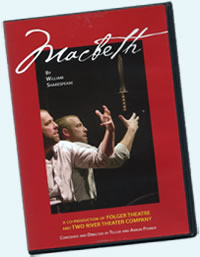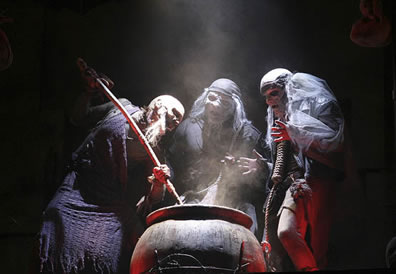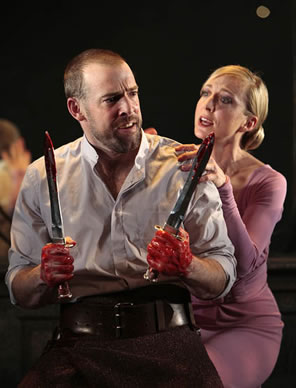Macbeth
A Bloody Magical Psychological Thriller
 Folger Shakespeare Library (2009)
Folger Shakespeare Library (2009)
Directed by Teller and Aaron Posner. With Ian Merrill Peakes (Macbeth), Kate Eastwood Norris (Lady Macbeth), Cody Nickell (Macduff), Scott Kerns (Malcolm), Eric Hissom (Porter et al.).
Magic and blood. These two signature elements of William Shakespeare’s Macbeth are what Aaron Posner collaborating with the latter half of the Penn & Teller magic act highlighted in their 2008 Folger Theatre/Two River Theater Company production: real magic (in the stage sense) and lots of blood. Lots and lots of blood.
The magic is cool; the blood is more pertinent.
This DVD is the stage production, filmed with and without a live audience and edited into one seamless whole, combining close-ups at key points with a whole-stage perspective in the Folger’s cozy Elizabethan theater. Sound mixing is the lone production blemish; depending on where the actors are on stage, their lines are not clearly picked up by the microphones, and the masked Weird Sisters are sometimes difficult to understand.
Nevertheless, this is a good representation of a production that swept the D.C. theater scene by storm and had a successful regional tour. That’s largely due its horror- action-film feel and the stagecraft magic Teller brought to the production with the help of Frank Ippolito’s masks and effects design. You get Buffy-like fight sequences and Weird Sisters literally melting into air. You see Banquo’s violent death, but you don’t see coming his second appearance as a ghost, which will give you a start even watching it on video (rerun it and you’ll see why it had a tremendous gotcha impact on the theater audience). You feel back-alley danger lurking in Thom Weaver’s lighting while Macbeth’s vision of the daggers borrows the magic of Disneyland’s Haunted Mansion. You shiver from the Psycho-sounding all-percussion soundtrack by John Kilkenny and shudder at the creepiest apparitions you’ll likely ever see. The ingredients the Weird Sisters throw into their pot—from the toad to the “finger of a birth-strangled babe ditch-delivered by a drab”—look disturbingly realistic, even as they turn their famous incantation into a witches' rap.

Andrew Zox, Cleo House Jr., and Eric Hissom as the Weird Sisters in Macbeth at the Folger Theatre in a 2008 co-production with Two River Theater Company. Photo by Carol Pratt, Folger Shakespeare Library.
One magic ingredient, though, has been diluted: Shakespeare. Posner is one of my favorite theatrical directors. His clever staging ideas step way outside traditional boxes, such as using masks in The Two Gentlemen of Verona, puppets in Measure for Measure, a fake English theatrical society for The Comedy of Errors, and Teller for Macbeth. He also shepherds indelible performances from his actors, as he does in this play with Ian Merrill Peakes as Macbeth and Kate Eastwood Norris as Lady Macbeth. However, Posner frustratingly toys with Shakespeare’s scripts, often to contrary effect.
In this Macbeth, he brings on Macduff (the virile Cody Nickell) in the first scene, and Lady Macduff also makes an early appearance. The idea is, perhaps, to give the audience a chance to get to know these key characters (he saves no acting parts with this maneuver). Shakespeare, though, significantly brings Macduff to the audience’s conscience right after the murder, and with one key line—pointing out that waking the king is his particular duty—Macduff is established as a faultline in the Macbeths’ plans, one that literally comes out of nowhere. Posner also superimposes scenes. The ambush of Banquo (Paul Morella) takes place around the Macbeths’ prebanquet dialogue (Banquo dies leaning against the throne). Macbeth’s aside on how he must “o’erleap” the Prince of Cumberland becomes a soliloquy that alternates with Lady Macbeth reading her husband’s letter. Posner here is highlighting—or, you could say, forcing—a juxtaposition of the calculating Macbeth and his impetuous wife that Shakespeare already has established by proximity of these scenes. The result is confusion (especially for an audience new to the play) and robbing Lady Macbeth, and later Banquo, of singularly powerful moments.
I have to admit, though, that Posner's rearrangement of Act I, Scene 4, is effective in that Duncan (Dan Olmstead) now states that the just-executed Thane of Cawdor “was a gentleman on whom I built an absolute trust” while the newly anointed Thane of Cawdor is standing on stage with him. Boy, is his “absolute trust” in the new Cawdor going to be violated in a big way.
While Posner may overmanipulate the text, he does bring out such significant points sometimes buried by other productions. Peake’s Macbeth is roused by the Weird Sisters’ prophecy that he will be king—he has surely wanted that before now—but he later stresses in an aside that their other prophecy, that he was Thane of Cawdor, came about by chance. Therefore, “If chance will have me king, why, chance may crown me without my stir.” His wife will leave nothing to chance, though. She wants her husband to reach the highest heights, and this conflict of attitudes courses through the play’s first half, and its consequences dictate the play’s second half.
Peakes, a superior Shakespearean actor who has graced the Folger boards with many memorable performances, is a fascinating Macbeth. He has a pent-up rage that makes him such an effective warrior in the first act, but even among friends he is quick to brandish his sword. Devon Painter’s costumes, in which the Scottish highlanders wear muted kilts with modern oxford shirts and leather coats as everyday wear and Celtic robes for formal occasions, establish a look that merges prehistory, modernity, and mythology into one look. In this setting, Macbeth is a barbarian with a strong sense of tradition trying to come to grips with an ever-refining society. Peakes slows down his speeches, working within Shakespeare’s verse to punctuate key phrases that allow us to see Macbeth’s psychology evolve while he weighs desire with conscience, ambition with practicality, the supernatural with social order. He fears only two things: his inward barbarian and his wife. “We will proceed no further in this business,” he tells Lady Macbeth as stoutly as he can, but we see at this moment that he is genuinely scared. He knows what’s coming.
So do we. We’ve already seen Lady Macbeth’s reaction to her husband’s letter, as Norris, fueled by her all-consuming belief in Macbeth, immediately begins to plot Duncan’s murder while steeling herself to countermand her husband’s gentler nature. She needs every ounce of her iron will to overpower Macbeth’s reticence, first attacking his manhood. “If we should fail?” he asks, and she gets right in his face and yells an exasperated, “We fail!” (Norris speaks it with exclamation instead of a question mark as in the original text). Then she pounds her fists on Macbeth’s chest as she says, “But screw your courage to the sticking-place, and we’ll not fail” like a football coach exhorting confidence into his quarterback. Then Norris’s Lady Macbeth shifts to another tactic: seducing her husband into committing the murder, stroking his ego. Notably, when Macbeth later takes the throne for the first time, Norris plays Lady Macbeth as immensely proud of him.
Peakes plus Norris playing the Macbeths is, in and of itself, powerful magic.
The focus—of the production as well as Shakespeare’s own creative attention—shifts to Malcolm (played with consistent nobility by Scott Kerns) and Macduff in the play’s second half. Nickell’s performance of Macduff’s reaction to the news of his butchered family is intensely internal, a grief too deep and personal to turn to rage—yet. “He has no children” Nickell speaks not as a cry that he will never be able to truly revenge his loss but as a stab of realization that deepens his great loss, that he will never know satisfaction even if he should kill Macbeth. That lays the groundwork for the production’s final fade-out on Nickell, Scottish society’s savior, as bloody savage, devoid of his own sense of humanity.
Ah, the blood. The bloodshed starts even before the play begins as a dramaturg discusses the role of magic and blood in the play, but before she can finish the Highlanders rampage onto the stage, stabbing her through both her heart and her speech (another great Teller slight of hand). The blood used in this production can literally be measured by gallons. But the most significant blood flow is off stage. Posner and company have picked up on how bloody, literally, is Macbeth’s murder of Duncan. Remember, Macbeth had earlier “unseamed [Macdonald] from the nave to th’chops and fixed his head upon our battlements.”

Ian Merrill Peakes as Macbeth and Kate Eastwood Norris as Lady Macbeth. Their performances delve deep into the psychologies of these two famous characters. Photo by T. Charles Erickson, Folger Shakespeare Library.
In such an anxious state as he displays in the moment leading up to his murdering the king, what exactly did Macbeth do to Duncan in that bedchamber? A key clue comes later from Lady Macbeth in her sleepwalking scene when she says, “Who would have thought the old man to have had so much blood in him?” Macbeth returns from the chamber after the murder with bloody daggers and hands and clearly off-kilter. He pointedly refuses to take the daggers back to the scene of the crime: “Look on’t again I dare not.” Lady Macbeth in a pique takes the daggers back to the chamber, but when Norris returns, her hands are not only bloody, her face is pale and shocked, and she struggles to present the bravado of her next speech. “A little water clears us of this deed,” she says, but not with much confidence. Macduff also emerges from the crime scene with blood on his hands and horrified almost beyond speech; Nickell looks as if he is about to be physically sick as he tries to sound the alarm.
Though Duncan’s body remains off stage, the moment triggers the excessive blood flow on stage. Banquo’s ghost is still bleeding profusely when he appears at the banquet. With a little help from Teller, Lady Macbeth in her nightmare not only can’t get the blood washed from her hands, she can’t get it to stop oozing from her hands, until she is covered in it (she ends up looking like Carrie at the prom). The two directors are here visualizing for the audience what Lady Macbeth sees.
This also dramatizes a seldom-remarked-upon psychological aspect of the play. It may be Macbeth’s troubled conscience that keeps him from sleeping and deepens his sense of desperation (or madness) to the point that he tries to manage the supernatural; but how does the even more ambitious Lady Macbeth go from a woman so eagerly goading her husband into murder—and remaining constant in this regard for a few more scenes after the murder—to a woman wracked by guilt? “Canst thou not…pluck from the memory a rooted sorrow, raze out the written troubles of the brain…?” Macbeth later demands of the doctor tending to Lady Macbeth. Even if Shakespeare himself is not portraying post-traumatic stress disorder, this production taps into our own ever-present awareness of this affliction and its all-consuming effect on even the most stalwart personalities who have a "rooted sorrow" they can't pluck from their memories and maddens them.
The DVD includes eight “making of” mini-documentaries, ranging from the teamwork of Posner and Teller to the depictions of the Weird Sisters. One highlight is the documentary showing how fight director Dale Anthony Girard created stage combat that seems more cinematic than theatrical. But the most important of the extras for both actors and students of Shakespeare is “Mr. and Mrs. Macbeth” with Peakes and Norris explaining their approaches to their famous characters, including a line-by-line anatomy of the “Screw your” scene.
After all, for all the bloody action and cool magic, it is the performances of Peakes as Macbeth, Norris as his wife, and Nickell as his ultimate nemesis that most merit purchase of this DVD, along with the performances of Eric Hissom. He plays a Weird Sister (can’t tell which), a delicious murderer, and the doctor who shifts from pompous to engaged, but his signature moment is as the Porter. Using the intimate Folger Theatre to great effect and relying on some ad-libbed enhancements of the text, Hissom’s Porter is Shakespearean comedy at its finest.
It’s another example of how this production may not be purely Shakespearean, but it achieves Shakespearean magic, nonetheless.
Eric Minton
November 9, 2012
Comment: e-mail editorial@shakespeareances.com
Start a discussion in the Bardroom



 Find additional Shakespeareances
Find additional Shakespeareances